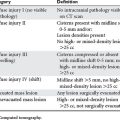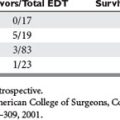CHAPTER 107 TRAUMA OUTCOMES
All surgeons who care for patients with injury are subject to increased scrutiny relative to the outcomes of their patients. In fact, all participatory physicians, nurses, technicians, hospitals, and state trauma systems should have a heightened interest in trauma outcomes. Not only does outcome analysis provide a platform for performance improvement and patient safety, but may have a significant impact on liability, cost, and reimbursement. As pay-for-performance initiatives emerge, the survival of trauma centers and systems may be at risk.
OUTCOMES
Outcomes may be viewed differently from the perspective of the patient, provider, payer, and society. The standard outcome parameters are outlined in Table 1. Although survival (live/die) seems straightforward, the endpoint in time may vary considerably, including in hospital, 30 days, 6 months, 1 year, and time to death. These variations project imprecision into many of the existing severity scoring and mortality prediction models.
EVIDENCE-BASED MEDICINE
The discipline of evidence-based medicine has emerged over the past decade to allow investigators to quantify the power of scientific studies based on the certainty of the scientific methods employed. Although simplistic, a classification system has been well received by the medical community that allows dialog among investigators (Table 2). Fortunately, the trend of dominance of class III data in the world of trauma outcomes is slowly giving way to significant class II and class I outcome studies in trauma and critical care.
| Evidence | Description |
|---|---|
| Class I | Prospective, randomized, controlled trials—the gold standard of clinical trials. However, some may be poorly designed, lack sufficient patient numbers, or suffer from other methodological inadequacies. |
| Class II | Clinical studies in which the data were collected prospectively; retrospective analyses based on clearly reliable data. Types of study so classified include observational studies, cohort studies, prevalence studies, and case–control studies. |
| Class III | Most studies based on retrospectively collected data. Evidence used in this class indicates clinical series, databases, registries, case reviews, case reports, and expert opinion. |
| Technology assessment | The assessment of technology, such as devices for monitoring intracranial pressure, does not lend itself to classification in the format above. Thus, for technology assessment, devices were evaluated in terms of accuracy, reliability, therapeutic potential, and cost effectiveness. |
In general, class I and class II studies provide the fuel for the strongest evidence-based guidelines on which to base the processes of trauma care (Table 3). The value of class III studies is to point the researcher toward an area of need and to help formulate the appropriate null hypothesis for a higher-power study. However, there are many clinical questions that have prohibitive barriers that prevent class I and class II studies, thereby augmenting the value of class III evidence.
Table 3 Trauma-Related Evidence-Based Guidelines
PERFORMANCE IMPROVEMENT AND PATIENT SAFETY
The Surgical Care Improvement Project (SCIP) is a national initiative to improve outcomes for patients having surgery. This project represents a coalition of 10 organizations, including the American College of Surgeons, Agency for Healthcare Research and Quality, Centers for Medicare and Medicaid Services, and Joint Commission on Accreditation of Healthcare Organizations. Although some of the initiatives are not specific to trauma care, many relate to critical care and general care of any patient, including those with injury (Table 4). Most of these initiatives are centered on evidence-based guidelines reflective of class I or II outcome studies. Therefore, it is important to understand the very strong link between trauma/critical care–related PIPS and outcome studies.
Table 4 Surgical Care Improvement Project: Process and Outcome Measures
| Infection |
NATIONAL TRAUMA DATA BANK
In 1989, the Regents of the American College of Surgeons established the National Trauma Data Bank (NTDB) subcommittee under the aegis of the American College of Surgeons Committee of Trauma. The goal of this initiative was to develop a database that would serve as a national repository of data on trauma center care in the United States. After completing its preliminary work, including establishing the standard data set of 93 elements, the NTDB initiated a first call for data in 1997. It continues to do so annually, requesting data from the previous year. As of 2005, the NTDB has accrued over 1.4 million records from 405 U.S. trauma centers in 43 states, territories, and the District of Columbia, making it the largest aggregate of trauma data ever assembled. Table 5 outlines research studies that were at least in part based on the NTDB.
Eastern Association for the Surgery of Trauma Home page. www.east.org/guidelines
National Surgical Quality Improvement Project Home page. https://acsnsqip.org
National Trauma Data Bank Home page. http://ntdb.org
Rhodes M. Trauma outcomes. In Moore EE, et al, editors: Trauma, 5th ed., New York: McGraw-Hill, 2004.
Society of Critical Care Medicine: Home page. www.sccm.org
Surgical Care Improvement Project: Home page. http://www.medqic.org/scip/
U.S. Department of Health and Human Services: Medicare Website, CMS pay for performance measures. www.medicare.gov







